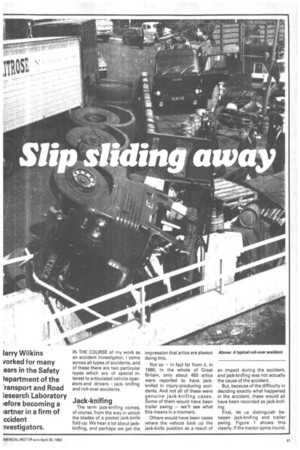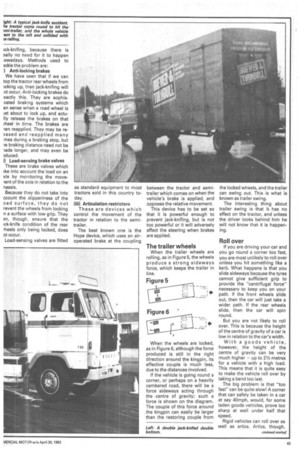larry Wilkins vorked for many ears in the Safety )epartment
Page 43

Page 44

Page 45

Page 46

If you've noticed an error in this article please click here to report it so we can fix it.
of the ransport and Road research Laboratory oefore becoming a lartner in a firm of ccident nvestigators.
IN THE COURSE of my work as an accident investigator, I come across all types of accidents, and of these there are two particular types which are of special interest to articulated vehicle operators and drivers — jackknifing and roll-over accidents.
Jack-knifing
The term jack-knifing comes, of course, from the way in which the blades of a pocket jack-knife fold up. We hear a lot about jackknifing, and perhaps we get the impression that artics are always doing this.
Not so — in fact far from it. In 1980, in the whole of Great Britain, only about 450 artics were reported to have jackknifed in injury-producing accidents. And not all of these were genuine jack-knifing cases. Some of them would have been trailer swing — we'll see what this means in a moment.
Others would have been cases where the vehicle took up the jack-knife position as a result of an impact during the accident, and jack-knifing was not actually the cause of the accident.
But, because of the difficulty in deciding exactly what happened in the accident, these would all have been recorded as jack-knifing.
First, let us distinguish between jack-knifing and trailer swing. Figure 1 shows this clearly. If the tractor spins round, hits the trailer, and the vehicle starts to go across the road completely out of control, this is called jack-knifing.
Trailer swing is where the trailer swings round as shown.
Figure 1
Jack-knifing and trailer swing are both caused by road wheels locking up, but by different wheels. When brakes are applied, if they are applied too heavily for the load and the road surface, then some or all of the wheels may lock. They may not all lock together.
For jack-knifing, we need to consider only the tractor wheels. In Figure 2, the tractor fronts are locked, and the others are rolling.
Figure 2
The tractor is shown at an angle to the semi-trailer — the small angle which is always present has been exaggerated to make things clearer. The arrows show the forces produced by the wheels.
The front wheels are locked, thus they have no steering ability, they just behave like lumps of rubber being dragged along the ground. The rear wheels are rolling, so they can steer. Because they are pointing to the right, they steer the back of the tractor to the right and this automatically keeps it in line. Whichever way it starts to deviate, the vehicle is always brought back into line.
Thus in this condition the vehicle is stable. It won't jackknife. But of course it can't be steered.
Figure 3 — tractor rears. locked, the others rolling. This is the dangerous condition! The locked rear wheels have no
steering ability, and just drag along the ground. The rolling fronts can steer — in the drawing they are pointing to the right, and thus they steer the front of the tractor to the right. This is the wrong way for stability, and whichever way the tractor starts to deviate, the front wheels make it worse.
In practice, the tractor spins round rapidly, faster than the driver can correct by steering, and the vehicle jack-knifes.
It is interesting to see that it is not the locked rears which actually cause the jack-knife, but the rolling fronts!
Figure 4 — all the tractou wheels are locked. In this condition none of the wheels has any steering ability. There is nothinc to cause it to jack-knife, but therE is nothing to keep it straight. ThE vehicle is in a sort of neutra equilibrium.
Figure 4
What happens in practice ir this condition is that the vehicli may just start to jack-knife jus as it comes to rest. This sometimes called "delayed jack knifing" and is not particularll dangerous.
What can be done about jack-knifing?
Perhaps we should say in stead what has been done abou ack-knifing, because there is sally no need for it to happen owadays. Methods used to ackle the problem are: i) Anti-locking brakes
We have seen that if we can top the tractor rear wheels from )cking up, then jack-knifing will ot occur. Anti-locking brakes do xactly this. They are sophiscated braking systems which an sense when a road wheel is 1st about to lock pp, and actuIly release the brakes on that /heel in time. The brakes are len reapplied. They may be re3ased and reapplied many mes during a braking stop, but -le braking distance need not be jade longer, and may even be 3duced.
i) Load-sensing brake valves These are brake valves which Ike into account the load on an xle by monitoring the move-lent of the axle in relation to the hassis.
Because they do not take into ccount the slipperiness of the oad surface, they do not revent the wheels from locking n a surface with low grip. They an, though, ensure that the ick-knife condition of the rear +heels only being locked, does ot occur.
Load-sensing valves are fitted as standard equipment to most tractors sold in this country today.
(iii) Articulation restrictors These are devices which control the movement of the tractor in relation to the semitrailer.
The best known one is the Hope device, which uses an airoperated brake at the coupling between the tractor and semitrailer which comes on when the vehicle's brake is applied, and opposes the relative movement.
This device has to be set so that it is powerful enough to prevent jack-knifing, but is not too powerful or it will adversely affect the steering when brakes are applied.
The trailer wheels
When the trailer wheels are rolling, as in Figure 5, the wheels produce a strong sideways force, which keeps the trailer in line.
Figure 5
When the wheels are locked, as in Figure 6, although the force produced is still in the right direction around the kingpin, its effective couple is much less, due to the distances involved.
If the vehicle is going round a corner, or perhaps on a heavily cambered road, there will be a force sideways acting through the centre of gravity; such a force is shown on the diagram. The couple of this force around , the kingpin can easily be larger than the restoring couple from the locked wheels, and the trailer can swing out. This is what is known as trailer swing.
The interesting thing about trailer swing is that its has no effect on the tractor, and unless the driver looks behind him he will not know that it is happening.
Roll over
If you are driving your car and you go round a corner too fast, you are most unlikely to roll over unless you hit something like a kerb. What happens is that you slide sideways because the tyres cannot give sufficient grip to provide the "centrifugal force" necessary to keep you on your path. If the front wheels slide out, then the car will just take a wider path. If the rear wheels slide, then the car will spin round.
But you are not likely to roll over. This is because the height of the centre of gravity of a car is low in relation to the car's width.
With a goods vehicle, however, the height of the centre of gravity can be very much higher — up to 21/2 metres for a vehicle with a high load. This means that it is quite easy to make the vehicle roll over by taking a bend too last.
The big problem is that "too fast" can be quite slow! A corner that can safely be taken in a car at say 40mph, would, for some laden goods vehicles, prove too sharp at well under half that speed.
Rigid vehicles can roll over as well as artics. Artics, though,
have a particular problem in this respect, for two main reasons: first, because of the normal play in the kingpin/rubbing plate assembly, the front end of a semitrailer may be able to roll through quite an angle before much resistance is provided by the tractor. This makes it easier to roll over than a rigid.
Secondly, the driver, being in the tractor unit, will not feel any roll over developing until the trailer has rolled quite a lot and started to take the tractor with it By then it will be too late for corrective action.
Thus, drivers of artics carrying a high load, must be very careful when negotiating corners. The sort of speed that can result in a roll over is, for typical small roundabouts, 12mph on a radius of 50 feet.
Roll over on a straight road?
Yes, tests at the Transport and Road Research Laboratory have shown that roll over can occur on a normal two-lane single car riageway straight road! If an artic is being driven on such a road, perhaps in a slightly spirited fashion, and the driver swerves across the road to pass an obstruction such as a parked car, then if he swerves too violently this can result in a roll over.
Analysis of the vehicle's speed and path taken, will still show that it is a question of going too fast for the curve.
Roll over through going too slow?
No, definitely not. Some years ago the theory was put forward that, in some circumstances, if roundabouts were taken at a higher speed this could make the artic less likely to roll. Tests at the Transport and Road Research Laboratory have shown this to be completely wrong. Unfortunately some people still believe this today, and I often come across this view being expressed.
The theory was, at first sight, reasonable. It was pointed out that all vehicles have a natural frequency for roll. By this we mean that if the vehicle is pushed to one side, and then allowed to return freely, it will rock on its springs at a definite frequency of so many movements per second.
The theory then said that when a vehicle goes round a roundabout, it is steered to the left, then to the right, then to the left. It was suggested that if the frequency of the left/right/left steering movements coincided with the natural frequency of roll, then the roll could build up and become larger than it would have been had the vehicle gone faster, or slower.
Unfortunately for the theory, tests have shown that the natural frequency is such that it cannot tie up with the steering frequency, and the theory was disproved. It is a great pity that this theory was ever put forward, because it is still held by some people today.
All the practical tests which have been carried out have shown that roll over is simpl) matter of going too fast for t curvature of the path.
What can be done?
I think driver education is t only answer. Drivers must aware of the fact that "too fa: can be quite slow. Also, if th do get near to roll over, th must slow up and/or straight out, and they must do this VE quickly indeed.
Various devices have be suggested, such as a warni buzzer which will sound whey certain sideways force caus by excessive cornering has be reached. It is, though, genera believed that it would be too I; for any corrective action by t time the warning had be given.




































































































